Archive for Uncategorized
January 30, 2006 at 8:24 pm · Filed under Uncategorized
We were sorry to say goodbye to Charles and Lynn, but they sent us off in style with a nice breakfast in their 34 foot Excella. Yes, you can serve breakfast for five on an Airstream dinette — as long as one person is flexible about where they sit.
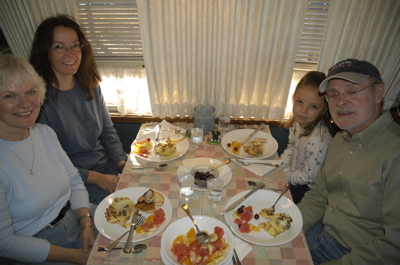
Our travel today was very short. All we needed to do was get down to Tucson, about 60 miles north and 2,000 feet lower in altitude. Because we are expecting a guest, we thought it would be a good idea to find a full-hookup campsite, so we ended up at the sort of place we don’t usually go to: a Big Honkin’ RV Resort.
Here are the specs: 400 sites, 266 pull-thrus. W/E/S at every site, plus cable TV, a Camping World store, a restaurant, “planned activities” (whatever those are), a mobile power-wash that comes to your site to clean your RV for $3 per foot, two swimming pools, and even some sites with personal jacuzzi tubs.
A place like this has nothing to do with communing with nature, or “getting away from it all.” The Big RV Resort experience is about … well, I don’t know what it’s about. It’s certainly not about saving money, since most of our neighbors are in giant Class A motorhomes that cost $100-300k. Our silver trailer sticks out in this fiberglass crowd.
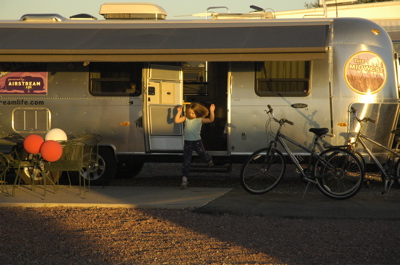
This week Eleanor and Emma are going to try to hit some of the enormous Tucson gem show going on now all over the city. Emma is a nut for rocks and minerals now, and Eleanor has become a fan of opal since our find on the California coast. I hope to join them at one or two of the venues later this week, work permitting.
Did you guess what the mining equipment in the previous post was? It was a two-seat “sanitary cart.” In other words, it was the toilet. Keep in mind the temperature in the mine runs 46-52 degrees year-round, and those seats are metal. Plenty of reason to keep your bathroom break short.
January 27, 2006 at 11:01 am · Filed under Uncategorized
Did I mention that Patagonia is at about 4400 feet elevation? It does get pretty nippy here at night. This morning I woke up to find our water hose frozen. The hose we used (one of those roll-up types you can get at Camping World) has developed some tiny pinholes over the months, and so it acts as a sort of ground watering system. You can barely see the miniature sprays, but this morning their existence was made very clear by the little ice formations in the lawn.
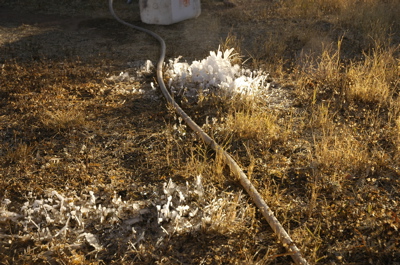
Time to get a new hose.
Over the past few days I’ve talked about the nearness of Mexico and how it influences life along southern Arizona. But nowhere has this been more apparent than here in Patagonia.
Because of the rugged terrain, the border here is very porous. The Border Patrol maintains a huge fleet of vehicles in the next town, Sonoita, and they have all the toys: night-vision goggles, ATVs, paddy wagons, cruisers, trucks, and helicopters. Still, I am told they catch only one in ten.
Last night while I was sitting in the dark on a bench outside the Public Library (snarfing the free wifi signal), a DEA or Border Patrol helicopter came by and began circling the town at low altitude with a multi-million candlepower spotlight. They hit me with the light a few times as they passed, in their hunt for drug runners from Mexico. Somewhere, perhaps only a few hundred feet away, someone was hiking north with a 60-lb sack of marijuana on his back, trying to evade the infrared eyes of an observer in the right seat of a Blackhawk helicopter.
It’s commonplace to see Border Patrol trucks off the highway every night, spotlighting and capturing “mules” (drug couriers) and UDAs. Hike into the backcountry and you’ll see piles of trash dumped where they walked the dry washes in the dark. They have no interest in Patagonia — it’s just the first of many towns they must pass to get to the American Dream. But we don’t see the people themselves. They are, like the poorest third of this town, a subtle presence most of the time.
The one time they are visible is when walking south. A drug courier, having made his drop, walks home again along the roadway. At one time the Border Patrol used to pick them up and deport them, but then realized they were just becoming a free taxi service for drug runners. So now, if they spot somebody heading south, they let them keep walking.
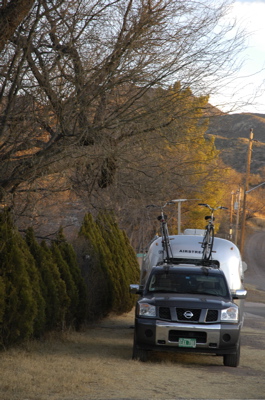
All these little intrigues go on around us, but Patagonia takes little heed. Our courtesy parking spot under the big mesquite trees on the corner of 4th and Duquesne is quiet, and we have been undisturbed. The locals slow down and stare at the trailer as they go by, but nobody has had the temerity to knock on our door yet. Still, I am reliably informed that everyone in this small town knows we are here. We may have an Open House later this weekend, just to satisfy curiousity.
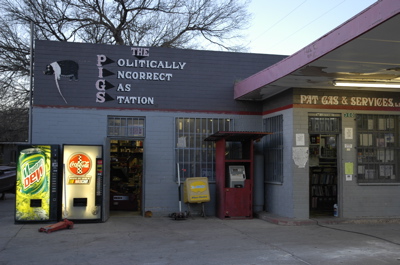
We wandered the town Wednesday night to see some of the eclectic features. There are many: the “Politically Incorrect Gas Station” (PIGS), the one-room Museum of the Dead, Velvet Elvis Pizza Parlor, Dos Palmas Vacation Resort, the combination nightclub and community center, and the backyards filled with “antiques” of all descriptions. Patagonia has layers of complexity in it that we have barely begun to appreciate. It is without a doubt the most peculiar town we have visited in the past four months.
Would you like to join us for a mini-caravan? Check our Schedule page to see where we will be in the next three months. If you can cross paths with us for a few days let us know by clicking the “Contact Us” link.
January 25, 2006 at 11:05 am · Filed under Uncategorized
Charles was right. Patagonia is a very interesting place.
From one perspective, Patagonia is severely divided by economics. At least one-third of the community is fairly poor. You see their homes in the midst of town, sometimes neat but careworn, other times ramshackle and cluttered with decades of now-worthless possessions. It seems nearly every tiny town lot has an old travel trailer in it parked next to the house, with expired plates and cracked windows, yet often these trailers are still being inhabited full time by an in-law or cousin.
Another significant slice of the community is very wealthy. They own substantial ranches around town, and tucked up in the hills. These are multi-million dollar properties, but most are merely second homes for their owners, who fly in from California, northern Arizona, and even Austria. For some, raising cattle on these “show ranches” is probably a sideline that allows the owner to say he owns a working ranch. Others have dispensed with even that pretense and live in elaborate glass-sided architectural creations perched atop hills, surrounded by acres of mesquite trees and tall grass.
But the real story of Patagonia is its history, which permeates the place so thoroughly that a walk down the block brings up a thousand stories. Nothing in Patagonia seems new. Thankfully the town was never large enough to suffer the scourge of “urban renewal” and modernization in the 50s and 60s. Some of the locals live in adobe houses that are probably 50 or more years old. Almost everything standing is historic, and just a few miles out of town you can find the remains of abandoned mining towns that held 1,000 or more people for a few brief years.
The library, where I walk each day to borrow their free wifi, is housed in the former Patagonia Hotel, built by a former solider, John Cady, starting around 1900. He wanted to build the finest hotel of its type west of the Mississippi, and after years of expansion, he finally did it.
Across the street is a marvelous old western-fronted building with “Lopez Pool Hall” in faded paint on the facade. Next door is a beautifully restored home that has become a B&B, and across from that is the Dos Palmas “vacation home”, a restored 1958 Spartan Imperial Villa permanently parked behind a fence. It’s pretty cool looking from the outside. (See the website for pictures). Patagonia is a funky amalgam of artistic vision, American history, and graceful decay.
People come here for that. There are adobe houses and wonderful western-fronted storefronts are filled with artists and accomplished “dropouts” from all over the world. Late at night we see the glare from a welder who is making incredible sculptures from reinforcing steel bars. Charlie tells us stories of nearly everyone who is here: the chef from New Orleans (displaced by Hurricane Katrina), the fellow who dropped out so thoroughly his friends held a funeral for him and placed a gravestone in the local cemetary (he’s still alive), the heiress with the dude ranch, the Austrian Count’s wife who loves giant concrete balls, and the local fresh-vegetable cult. This place is a writer’s dream, stories everywhere.
I’ll post photos from all over town in a day or two. Meanwhile, I’ve got to catch up on the Spring magazine issue and work out some plans for our next few weeks. We will be heading to the Tucson area next week, then traveling through southern New Mexico and heading to a rendezvous in west Texas.
January 24, 2006 at 10:24 am · Filed under Uncategorized
Before we left Organ Pipe Cactus National Monument, we stopped at the Visitor Center one last time. Emma had completed all the requirements for her first Junior Ranger certificate, so we went in to have her take the oath and receive her badge. She’s very proud of it.
The Tohono O’odham Indian Nation was quiet. Lots of open road, not much to see or visit. I didn’t score any prickly pear jam, sadly.
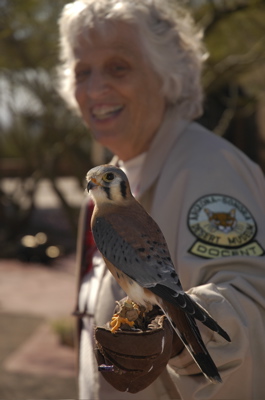
A Kestrel on the arm of a Desert Museum docent
We ended up a few hours later at the amazing Arizona Sonoran Desert Museum just west of Tucson. That place is fantastic ““ highly recommended. It’s a superb place for taking wildlife photos. I captured a few more hummingbird shots, as well as many other creatures and plants. (Check out the new photos I uploaded.) We stayed until closing, and then headed another two hours to our destination: Patagonia, AZ.
Why Patagonia, a off-the-beaten path western town up in the hills? I’m not sure yet. Our friends Charlie and Lynn winter here and they’ve raved about the place. It seems to be one of those rare “undiscovered” gems, far enough from the cities and off the beaten path enough that it doesn’t get a huge influx of tourists, yet genuine, historic, and friendly. So we took Charlie’s advice and came down. The offer of free courtesy parking with water and electric had nothing to do with it “¦ but it was a nice incentive. We’ll stay until the end of January, and then relocate up to Tucson for a few days.
January 22, 2006 at 8:33 am · Filed under Uncategorized
All along I-8 through southern California, the nearness of Mexico is readily apparent. It lurks across the border, sometimes only a few hundred feet away, sometimes a few miles. We have seen dozens of Border Patrol vehicles along the roadside, and we have passed through checkpoints along lonely roads near Anza Borrego, Yuma, and Organ Pipe Cactus National Monument.
From I-8 you turn south at Gila Bend, a tiny desert town that one might think would forever be a speck on the desert. A great place to “eat food, get gas” before heading somewhere else. But even Gila Bend is starting to feel the impact of Phoenix’s burgeoning suburbs 50 miles away ““ the newspaper is printing optimistic articles about how locals stand to get rich quick selling desert tracts to Phoenix commuters.
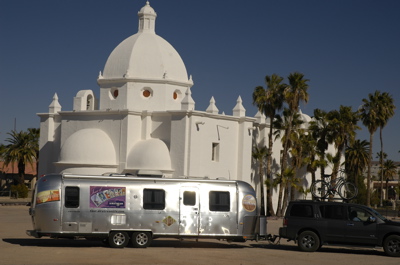
We stopped in the town of Ajo along Rt 85, expecting that it would be yet another dying desert town of the southwest. Ajo is a relic of copper mining, a town left over when the giant open-pit mine was shut down in 1985. But this little town is a surprise. It is still alive, with families enough to fill a small high school, a marvelous Spanish Colonial Revival-style plaza in the center, and a historic district filled with tiny copper miners’ bungalow homes. There is a historical museum, a downtown filled with shops, three real estate agencies, and several beautiful whitewashed stucco churches in the Mission style.
Ajo is a landlocked town, destined never to grow. It is surrounded by Air Force testing range to the north, the Cabeza Prieta National Wildlife Reserve to the east, the Tohono O’odham (Native American) Nation to the east, and Organ Pipe Cactus National Monument to the south. It’s the perfect place for someone who wants to become a desert rat, retire cheap, or who wants to live free of the pressure of rising real estate costs and sprawl. You can buy a fixer-upper for $40,000 and live in the endless sunshine and wide-open space.
The Mexican influence is apparent here, too, with “Mexican Insurance” signs all along the highway strip in Ajo, and a strong Mexican population living alongside the Border Patrol officers and Sheriff’s Department officers who make up a large portion of Ajo’s community today. Since 2001, the general beefing-up of the border has resulted in a swell of law enforcement in border towns, and Ajo is the nearest town to the crossing at Lukeville.
From the campground in Organ Pipe Cactus National Monument, we can see the lights of Mexico at night, but they are mostly from cars in the tiny border town of Sonoyta, six miles away. There’s not much on the southern side until you get to Puerto Peñasco (Rocky Point) on the Gulf of California, 60 miles away. The volunteers here in the park organize a weekly market run to get food there, which explains why the presenter at last night’s amphitheater show had fresh shrimp for dinner, here in the middle of the desert.
I was tempted to suggest we go over the border too, just for a look-see, but the nearest spot to get Mexican insurance is back in Why, 26 miles north. There’s too much to do right here in the Monument to justify spending that amount of time in the car today. We will only be here two nights before we head to Patagonia.
Our batteries are dead this morning. We boondocked in a Yuma parking lot on Friday night, and there’s no electric in this campground, so Saturday night was a second night without plugging in. Overnight temperatures here in the clear desert nights have been in the 40s. With the furnace running both nights, the batteries have been drained to a bare minimum. The refrigerator’s control board is still working, but the propane detector gave up this morning, and the water pump is pretty much not pumping anymore.
It’s clear that the trailer does not recharge well from the truck. I believe that the voltage output from the truck is not ideal for re-charging batteries. So even though we towed for three hours yesterday it didn’t do much. Even still, the generator would have saved us, but this park has unusual generator hours: noon to 4 pm. We arrived at 3:40 pm.
There’s nothing for it but to wait until noon and run the generator for the full four hours we are allowed. I’m glad we have a moderately quiet Honda eu1000i, but still I’d rather have solar. This is at least the third time we’ve been caught low on power, waiting for generator hours to get charged back up. Eleanor and I have become convinced that for full-timers who want to visit National Parks (which often do not have electric sites), there is no substitute for solar panels and a good-sized battery bank.
January 20, 2006 at 3:33 pm · Filed under Uncategorized
Hit the road today. That slow leaking tire turned out to have a nail in it. We must have got it between San Diego and Anza Borrego, because I had to put 10 lbs of air in it before we left Anza-Borrego. Fortunately, Mike has air-powered tools and big hydraulic jacks. He had that tire off in minutes, and Discount Tire put a patch in it in less than 15 minutes.
For good measure, Mike insisted on checking the torque on all our lug nuts (which were fine), increasing the air pressure to 65 psi on all tires (we were using 55 psi, but a look at the manual showed that was a bit low), and checking the battery water levels too. It’s a great feeling to depart with all those things checked.
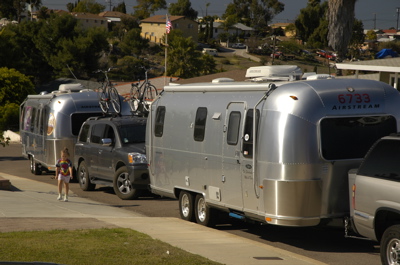
Departing Mike & Terry’s in a mini-caravan
I-8 was beautiful today. Couldn’t ask for nicer scenery or weather. At 4000 ft near Jacumba it was only 47 degrees, but by the time we got back down to sea level in Ocotillo it was a balmy 70 again. We parked for a couple of hours to have lunch, and to get online to book some air tickets for late March (from Florida, where we expect to be by then), and then proceeded to Yuma, AZ.
We’re boondocking it at a parking lot with a bunch of other RVs for the night. Eleanor is off re-stocking our groceries with Emma while I catch up on stuff, and then tomorrow we’ll head directly to Organ Pipe Cactus National Monument. It’s in the middle of nowhere, right on the Mexican border, and I expect we will have neither cell phone service nor Internet, so our next update may be after the weekend. But if I can get online sooner, I’ll post an update from that remote desert park.
January 19, 2006 at 8:31 pm · Filed under Uncategorized
One last day in San Diego before we hit the road again. It has been great here, and I’m sure we will return. The past week of downtime has given us a chance to reflect on what we are doing, but surprisingly there isn’t much we want to change about our trip at this point. Mostly the week’s hiatus gave us a chance to think about what to do next, and so we’ve come up with some really interesting plans that I’ll tell you about later.
Mike took us over to Cabrillo National Monument for a tour, as promised. I was amazed at the stunning panoramic views of San Diego available from Point Loma!
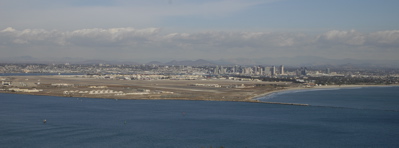
The monument is more than one might expect. There’s a very interesting interpretive center with history of Cabrillo’s explorations up the California coast, a Visitor Center with the awesome view, a lighthouse, grey whale-watching area, and more. While we were there, a group of docents were giving talks in period costume. It was a great visit, which we topped off with a Mexican dinner and ice cream with Mike and Terry.
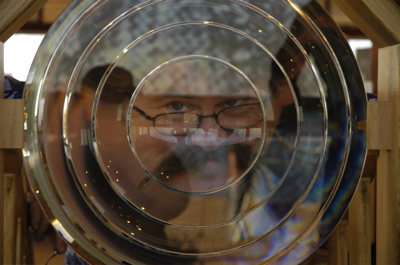
Mike looks through a fresnel lens in the Visitor’s Center.
Sam Halderman, who we met in Borrego Springs, reports via email that the winds along I-8 to El Centro were fierce today. He thinks we’ll find better towing conditions on Friday. If we get out there and the wind is still high, we’ll have to slow down or even find a spot along the way to park overnight.
I’ve noticed that the rear curbside tire of the Airstream has lost a lot of air this week. We definitely have a slow leak. Mike will help me take it off tomorrow and we’ll probably bring it over to the local tire shop in the morning before we hit the road. Much better to deal with it here than before we get out in the desolate stretches of I-8 in eastern California and Arizona.
« Previous entries ·
Next entries »











